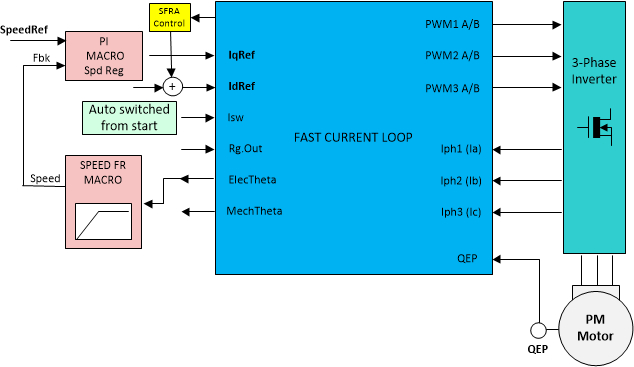SPRACM9B June 2019 – November 2020 F29H850TU , F29H859TU-Q1 , TMS320F28384D , TMS320F28384S , TMS320F28386D , TMS320F28386S , TMS320F28388D , TMS320F28388S , TMS320F28P650DH , TMS320F28P650DK , TMS320F28P650SH , TMS320F28P650SK , TMS320F28P659DH-Q1 , TMS320F28P659DK-Q1 , TMS320F28P659SH-Q1
- Trademarks
- 1 Introduction
- 2 Benefits of the TMS320F2838x MCU for High-Bandwidth Current Loop
- 3 Current Loops in Servo Drives
- 4 Outline of the Fast Current Loop Library
- 5 Fast Current Loop Evaluation
- 6 Incremental Build Level 1
- 7 Incremental Build Level 2
- 8 Incremental Build Level 3
- 9 Incremental Build Level 4
- 10Incremental Build Level 5
- 11Incremental Build Level 6
- 12Incremental Build Level 7
- 13Incremental Build Level 8
- 14References
- 15Revision History
11.1 Integrating SFRA Library
C2000™ Software Frequency Response Analyzer (SFRA) Library and Compensation Designer in SDK Framework describes the SFRA tool and guides you on how to integrate it into the C2000 platform can be found at:
C:\ti\c2000\C2000Ware_DigitalPower_SDK_<version>\libraries\sfra\Doc
The embedded firmware is available as a library in the DigitalPower SDK at:
C:\ti\c2000\C2000Ware_DigitalPower_SDK_<version>\libraries\sfra
The SFRA GUIs are available as executable applications in the DigitalPower SDK at:
C:\ti\c2000\C2000Ware_DigitalPower_SDK_<version>\libraries\sfra\gui
Some example projects to understand SFRA are available at:
c:\ti\c2000\C2000Ware_DigitalPower_SDK_<version>\libraries\sfra\examples
In the ISR code, there are two functions that inject noise for SFRA and then collect the feedback data from the loop, they are:
- injectSFRA()
- collectSFRA()
The roles of these functions are self-explanatory from their names. They should be used in the sequence they are used in the code to collect the data in right sequence.
- The disturbances due to analog signal path and quantization will impact the loop performance and hinder high bandwidth selections that can be verified using SFRA results. Therefore it is important to provide a current feedback with a higher SNR.
- When evaluating current loops, if it is possible to hold the motor speed constant, it will help to minimize the impact of speed jitter related errors in the SFRA results. This is particularly useful when studying the Iq loop. If the voltage decoupling of current loop is good, then this requirement may not matter.
This tool provides the ability to study the D-axis or Q-axis current loops or the speed loop. The motor can be run at different speed/load conditions and at different bandwidths and the performance can be evaluated at each of these conditions. It can be seen that the controller can provide the designed bandwidth under all these conditions with a certain tolerance.
 Figure 11-1 Level 6 Block Diagram
Figure 11-1 Level 6 Block DiagramThe implementation block diagram is given in Figure 11-1. The SFRA tool injects noise signal into the system at various frequencies and analyzes the system response and provides a Bode Plot of the actual physical system as seen during the test.